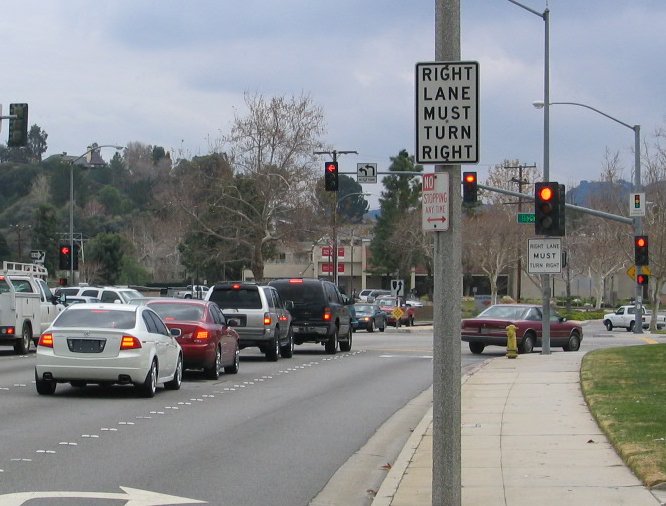If you haven't
already done so, please read Defect # 4 on the Home page
Sign Placement
New (MUTCD) Guidance
In case you
are getting lost, here is how you got here:
Home >
Defect # 4 > Warning Sign
Requirements > Sign Placement
Home - Exp > Defect # 4 - Exp
> Warning
Sign
Requirements > Sign Placement
New
12-27-04, updated 1-15-15
The
discussion
in
the
box
below
was
contributed
by
a
reader
of
this website.

The
warning sign pictured above on the far side of
the intersection, appears to violate the
CalTrans rule (see box below) that signs should not be
installed on signal standards, and also could be
too small.
By a reader of this website:
|
Following is a discussion
about placement requirements of the California
SR56 (PHOTO ENFORCED) sign apparently necessary
for compliance with CVC 21455.5(a)(1), which
reads as follows: " [The following info was updated in Jan. 2015, to provide a working link and current page numbers.] The MUTCD is available at
the CalTrans website, and that online/electronic
version is the official version. The pages
referenced immediately following are found in
the official
Signs manual (24 MB file), Nov. 2014
edition. "Guidance: The installation of signs, including route shields, on signal standards should be avoided unless they directly affect traffic movements in the intersection." Figure 2A-2 (on page 116)
titled Examples of Heights and Lateral Locations
of Signs for Typical Installations, provides as
follows: "NOTES. These sign positions are typical and should be considered a standard. When physical conditions require deviation from these typicals, they should be documented." Section 2A.16 (on page 108)
also says (in Paragraphs # 04 & 11):
Section 2A.18 (on page 110)
titled Mounting Height, says (in Paragraphs #
04, 05 & 07):
Section 2B.55 (on page 180)
titled Photo Enforced Signs, says (in Paragraphs
# 00 & 01):
|
---------------------------------
RED LIGHT CAMERAS
www.highwayrobbery.net
www.highwayrobbery.net